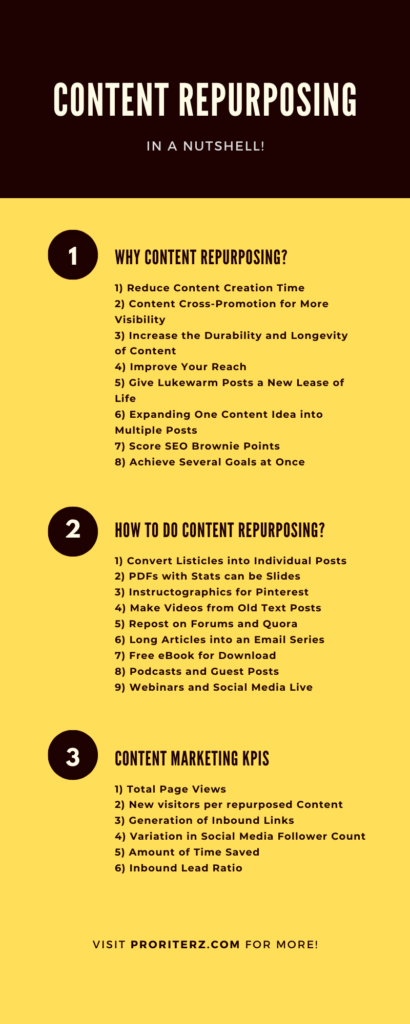
Why Should Content Repurposing be a Crucial Part of Your Content Marketing Strategy? [Updated reasons for 2021]

Creating content is not an easy task. Ask a blogger, and they’ll tell you how much time and energy they spend on searching for topics, researching the information, writing, editing, and whatnot. And how can we forget SEO?
When you publish a high-quality post, your website will gain more traffic, there will be more engagement, and your brand visibility will be higher.
From where do we get a continuous supply of content material for the website? After all, we have to consider the niche and target audience before planning a post. What if there are no new topics to write about? What will you do with the older posts on the site? Are they of no use any longer?
That’s where content repurposing saves the day by helping you use the existing content and give it a new twist to use it again for SEO and digital marketing.
Of course, there’s a lot more to content repurposing than just reviving old posts. The how, what, when, and why play a vital role, and we’ll be talking about all of it in this blog.
What is Content Repurposing?

Content repurposing means transforming an existing piece of work (content) into another format for another purpose. Is it not fully clear? We’ll explain.
Let’s consider a common day-to-day aspect of our lives. We wear a different dress every day. Yeah, we do repeat them (we’ll get to that point next).
Our dresses are the same as the content for a website. We all have preferences when we choose our apparel. Your wardrobe would be a combination of casuals, semi-formals, formals, and designer wear, each picked for different occasions.
The content on the website is no different since it’s a combination of themes, formats, and topics, but all related to your brand and niche. Over time, we replace the old dresses with new ones, and sometimes, we mix and match the old and new to create a style statement.
The same can be done with the content on your website by taking some old content and presenting it in a different structure and format. It’s as good as new again and can be used to attract a fresh set of audiences.
Do you have a blog post that’s been at the top of the chart for a long time? Take it out, brush it up a little if it needs to be updated, and use it to create a fresh post.
An old blog can be a podcast or a video, or an infographic. Maybe a blog series can be combined into an ebook, and so on. There are countless content repurposing ideas to try and reuse the existing content to pull new traffic to the website.
Okay, you now understand what content repurposing is. But why do you need to do it? Well, apart from not having to hunt for new topics every time, there are several other reasons to repurpose content.
There must be one question that’s bothering you. Why can’t you reshare the same old post instead of revamping the content? You can do that. However, if your followers have already read it, are they going to read it another time?
Not likely, right? Not unless you make significant changes and updates to the post, and that’s also a form of content repurposing. If you convert the same content into an audio or a visual format, those who have already read the post are likely to listen to/ watch it again.
Here, if you link the original post to the repurposed content, both your posts will be active and get good traffic. That’s a double bonus, isn’t it? According to content repurposing statistics, around 60% of marketers reuse content, not just once but as many as five times. They create consumable pieces for easy sharing.
Other Reasons to Repurpose Content
Reduce Content Creation Time

Reusing existing content saves time as you already have the basic details ready. You can use the quotes, statistics, images, etc. used in the original post again in the new format, and if you are turning a blog post into a podcast, you don’t need images either.
Content Cross-Promotion for More Visibility
Social media platforms (we mean every social media platform) have their own strengths. By posting content that aligns with the nature of the platform, you can improve your reach and increase brand awareness. For example, you can post infographics or videos on Instagram as links in posts don’t work, while you can share a Twitter thread with links, images, and hashtags.
Increase the Durability and Longevity of Content
When you post something every day, people might miss a couple of posts. Repurposing content will ensure that the old posts are revived while the new version is also promoted, and when you repurpose popular content from your website, you are increasing its lifespan by taking it to new users.
Improve Your Reach
When you post your content in multiple formats, you are naturally attracting users with varied tastes. Similarly, you can also reach out to users on different social media platforms and become a known brand in the industry. The more often the people see your name and logo, the higher the chances of them remembering your business.
Give Lukewarm Posts a New Lease of Life
Some posts just don’t get enough traction. It doesn’t matter that you put hours of effort into creating it. The posts just don’t strike a chord with the users. You aren’t alone. This happens to all of us.
Content repurposing services help us reuse the unsuccessful posts and boost them in a new and attractive manner. So what if a 4000-word article didn’t get enough hits? Turn it into an ebook or a downloadable PDF file, and people will grab a copy to read it when they have time.
Expanding One Content Idea into Multiple Posts
Some users like to read, some like to listen, and others like to watch. By repurposing the same content in different formats, you will reach all kinds of users. Your content will be consumed by people with different preferences. Also, a blog of 2000 words can be presented as a podcast of 4 episodes or a 6-video series.
Score SEO Brownie Points
Isn’t SEO the reason we work on so many posts? Repurposing content helps you get the desired SEO results because every quality post you publish on the site increases your reputation as a trustworthy brand.

When you get more traffic, it increases the website rank, and that again brings more traffic as the search engine puts your link in the top search results. You can also get backlinks from reputed sources that like and promote your content.
Achieve Several Goals at Once
Your website can get great organic traffic. Now, you have more chances of increasing the conversion rate. You can also generate offline traffic, and your repurposed content will be extensively shared on multiple platforms in various formats.
It will even boost your B2B marketing results. Aren’t you ticking many items on your list just by repurposing content?
What are the main KPIs for Content Repurposing?
KPIs are Key Performance Indicators based on which you measure the results of a strategy or a campaign. You need to choose the KPIs before you start planning your digital marketing strategy (or even your business, for that matter).
How else can you make out if your efforts are bearing fruit or not? The content repurposing workflow needs to be aligned based on the following metrics.
- What is the number of page views for the content? This includes the page views for the original as well as the repurposed content. How many more users could you attract? Here, you also need to focus on the retention rate to see if your existing followers are interested or not.
- How many visitors did your new post gain? Did the podcast reach audio lovers? How many businesses requested to download the whitepaper from your site?
- What is the engagement rate after repurposing content? What is the total viewership time for the repurposed videos? If very few people have seen the full video, understand that there’s something that needs to be changed.
- Are you able to generate inbound links from worthy websites? There are several SEO tools to check links and references leading to your site.
- Has the bounce rate reduced after repurposing the content? The lower the bounce rate, the better will be site’s ranking.
- How many social media followers did you gain after posting repurposed content, and how many of them are active? What is the rate of comments? And most importantly, what is the nature of the comments?
- How much time were you able to save by repurposing content? Were you able to optimize the resources?
- What is the email open rate, and how many new subscribers did you gain?
- Are you able to generate better leads after repurposing content? How many new leads did you close, and what’s the increase in the conversion rate?
There are many more KPIs you can focus on to measure and ensure that your content repurposing efforts are bringing successful results. If you want to learn more, join a content repurposing course and increase your knowledge.
Content Repurposing Vs. Fresh Content
Content repurposing is to use existing content to create new posts. Think of it as pairing an old shirt with new jeans or turning it into a light summer jacket.
Writing fresh content is similar to buying a new shirt for the occasion. You need to decide on the budget, the brand, the color, the material, and the reason for buying a shirt.
While it is wonderful to generate fresh content regularly, unless you can sustain the quality of your posts over time, it won’t deliver the expected results. Repurposing content is an effective way to ensure quality. Since you can reach a more varied target audience without spending too much time collecting data, it’s an added advantage.
The best way forward would be to use a combination of fresh and repurposed content to promote your brand. It will keep existing customers interested as well as bring new users regularly and help you increase the site traffic.
How to do Content Repurposing?

So here comes the answer to the big question of how to repurpose content. We’ve seen some methods as examples in the previous sections of the post.
Now, we’ll look at content repurposing examples in brief to get a better idea about the process. You can also read the detailed post on the famous platform, Semrush, to know how to plug in your content distribution game with repurposing.
Convert Listicles into Individual Posts
The list posts can be divided and expanded into individual posts so that you can interlink the posts with one another and the original ones.
PDFs with Stats can be Slides
If you have use cases or PDF files with complex reports, turn the data into easy-to-understand PPT slides as statistics are easy to read and understand this way.
Instructographics for Pinterest
Condensing a know-how post into an image for Pinterest brings more users as it’s easy to pin the images to their boards.
Make Videos from Old Text Posts
According to Statista, 85% of internet users prefer and enjoy video content. The ratio goes to as high as 95% in countries like Saudi Arabia and Turkey. Imagine the number of visitors you can gain by repurposing old posts and making videos to promote the same content.
You can either create a single video or make bite-sized videos and share them on social media. Link the original post with each video to let users decide which format they want to consume.
Repost on Forums and Quora
Reddit and Quora are great forums to repurpose content and answer users’ questions. Moreover, you can provide a backlink to the post to bring more visitors.
Long Articles into an Email Series
Do you have lengthy articles on the site which no one reads anymore? Convert them into a newsletter series and make it exclusive for the subscribers.
Free eBook for Download
Who doesn’t love a free ebook with useful information? If you have a themed series on your site, combine the posts into an ebook and give it away for free (for users who subscribe to the site).
Podcasts and Guest Posts
Podcasts are an audio version of a blog post. You can have podcasts on your website or join Stitcher, PodBean, TuneIn, etc. You can reuse the content in a different format and send it as a guest post on other platforms.
Webinars and Social Media Live
Conduct a webinar on one of the topics shared on your site to can reuse the same content and turn it into a lecture or a discussion. You can also host live sessions on Facebook, Instagram, etc.
Final Words
Content repurposing is effective in several ways. You can reuse existing content and give it a new appearance. In fact, you don’t need to wait until a post gets old to repurpose it. You can simultaneously work on publishing the content in different formats.
Hiring a content repurposing agency will help you streamline the process, increase organic traffic, improve conversion rate, and bring more returns. Make the most of the precious content you own.